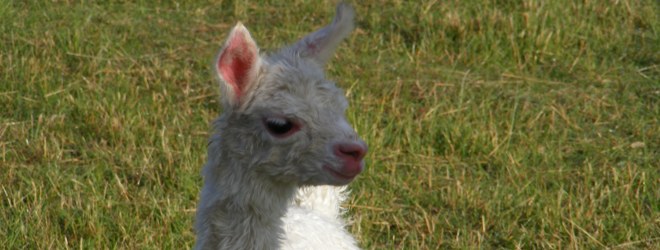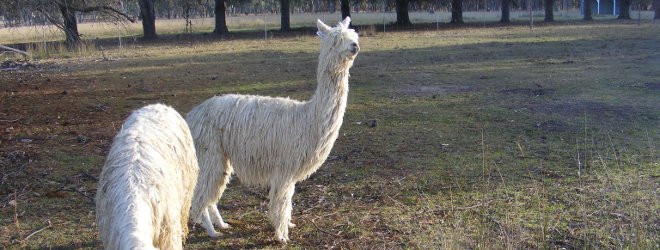Suri Cross Breeding
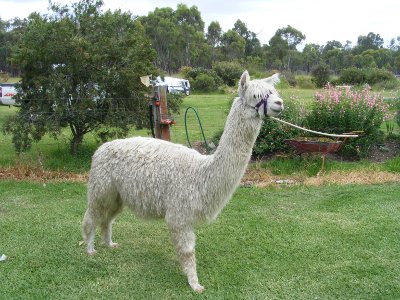
F1 suri
Forward
For newcomers to suri breeding, indeed sometimes for the not so new, it can be confusing learning and understanding all the different genetic terms and what they mean for a breeding programme. Please find at the end of this article some simple explanations of these terms. The discussion is not intended to be a technical or academic paper on aspects of genetics, nor suri cross breeding, but it is hoped it can help to unravel some of the "mysteries", for some of the terms and options related to a suri cross breeding programme. We use our own experience to discuss some of the possible reasons for undertaking cross breeding, and how it can be managed to progress toward defined goals. The genetic terms and explanations used though, are basic Mendelian genetic principles. It should also be noted and also stressed that some of the discussion and explanations also includes some of our own opinions, which are influenced by our own breeding goals; it is not meant to suggest that every suri breeder should be doing the same.
Further information on suri genetics and cross breeding can also be found on other suri breeder's web sites, such as the 2 on our links page. One has a very unique and fun but informative way of explaining suri genetics; the other goes into much more detail than here and gives a more in depth technical exploration of what is pure suri.
Discussion
The suri gene is dominant over the huacaya gene, this means that when a homozygous suri male alpaca is mated with a female huacaya alpaca, the resulting progeny will always be a suri, even though this cria will have both huacaya and suri genes; it will look like a suri in appearance i.e. it will have the suri fleece type. However, the probability of this occurring depends on whether the stud male used is a heterozygous suri male or a homozygous suri male. A homozygous male will produce a suri cria every time because a homozygous male is dominant for the suri gene. A heterozygous suri male will look like a suri, but will also have huacaya genes and a recessive suri gene; therefore it will produce huacaya progeny as well as suri.
At Shangrilah we only use homozygous suri males, because our aim is to produce suri animals. We are also gradually working toward having a herd of animals that largely consists of pure suri. If a breeder does not mind getting huacaya cria as well as suri, they could use a heterozygous suri male and many breeders do for a variety of reasons, there are some very nice heterozygous males. However, we not only choose not to because we do not wish to produce huacaya, but also because one of our initial interests in suri was the opportunity to breed an animal that is rare, thus we are aiming to eventually have a herd that is predominantly, if not all, pure suri, so that we might contribute to the overall suri gene pool and numbers. In Australia, the national herd consists of approximately 7% suri (keep in mind many of these will not be pure suri) and it is less than this in some other alpaca breeding nations.
As stated, heterozygous suri can also pass on the huacaya gene; therefore, if we used heterozygous males, we would not only have some huacaya cria being born, but we would also be producing a much higher percentage of suri with the huacaya gene, therefore we would not be truly achieving our longer term aim to add to the numbers of the considerably rarer suri.
Although it is generally accepted in any animal breeding programme, that a BC3 is close enough to being pure that it can be classed as pure, we have, for our own breeding programme, decided to take that a step further. As a BC3 suri has 93.75%(*) suri genes, in our minds there is still that 6.25% of huacaya genes. So at Shangrilah we are aiming to eventually have mostly suri animals that are BC4 or beyond. For us, this will be when we have achieved our aim to have a herd of pure suri.
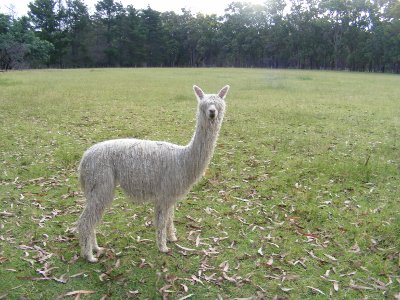
BC1 suri
Before we had clearly defined our own breeding goals and management plan however, we did use a heterozygous male over one of our F1 females, lucky for us, the cria was suri in type, however, she only has 65% suri instead of the 75% (*) that would be in a true BC1, so she is a second generation suri, but not a true BC1. This also means that her cria, although 3rd generation suri, will not be BC2's, as they will not have the expected percentage of suri genes for a backcross 2; this is regardless of whether the sire is homozygous or heterozygous, because the dam, our "65% girl", will not be able to contribute the required percentage of suri genes. This would be perfectly reasonable and ok for many breeders, but for us it is not, as it will mean all animals produced from this female's line, will take longer to reach pure status and they do not have a clear classification within classical genetic theory, such as the classification of BC2.
However, just because a suri cross bred animal is not pure, does not mean it necessarily does not have great suri fleece quality, indeed some suri crosses have beaten pure suris in the show ring. Generally speaking though, the fleece becomes more suri like (lustrous, and draped in silken locks), and the animals overall suri appearance becomes more apparent as one moves through a cross breeding programme, that is F1, BC1, BC2 and on to BC3. An F1 and a BC1 will be more likely, especially after the first fleece, to show some huacaya type traits, often noticeable by the “fluffy” appearance of the fleece, rather than the characteristic locking that drapes downwards from the midline, and is more likely to be attained as one grades up further toward pure suri. This can be seen by comparing some of the earlier crosses on our web site with those that are, or closer to, pure.
So, having said the above, if one of our goals is to breed more toward pure suri, why have we been undertaking a cross breeding programme instead of purchasing and only breeding pure suri? Well, one big reason is cost. Pure suri generally always cost a lot more than suri crosses do, so by starting with a cross breeding programme we have been able to grow our herd and our suri numbers at much less expense, and in a shorter time frame, although this does take longer to achieve our desired end result.
Another reason to cross breed is for hybrid vigour, although this fades out with each generation as you upgrade toward pure suri, we liked the idea of starting with animals who had hybrid vigour, so that if we made mistakes as we learned and fine tuned our husbandry practice and feeding regimes, the animals were more likely to cope better. It also enabled us to test the suitability of our land and climate with more vigorous animals before introducing pure suri.
Finally, we also began with a cross breeding programme because we liked the idea of the challenge to gradually work toward breeding our own lines of pure suri, which has given us the opportunity to draw from a wider pool of desired phenotypic and genotypic traits. Of course, environment also plays a role in influencing some traits.
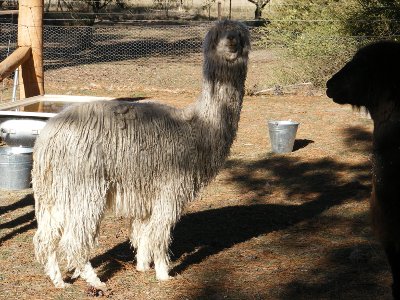
BC2 suri
Ultimately, whether to cross breed or use homozygous or heterozygous males is a matter of choice, depending on what ones breeding goals are; and our choices are not necessarily the correct ones but are the ones we have chosen in order to best meet our goals.
A few things to keep in mind when making these decisions though are:
- Homozygous and pure do not mean the same thing.
- Crossing say a F1 female with a BC1 heterozygous male, in strict terms, does not mean the progeny will be a BC1. Technically speaking, it is a 2nd generation suri, but not a true BC1 within the true meaning of backcross. This is because the progeny will not have the percentage of suri that a true back cross 1 would have, that is a BC1 from a homozygous suri male mated to an F1 female, because a heterozygous suri can always pass on the huacaya gene. Remember our 65% girl.
- One needs to be aware that animals imported from Peru or elsewhere in South America do not come with genetic ancestry information, so although they may be registered as suri and look like a suri, there is no way of knowing if the animal carries the huacaya gene, so until tested there is no way to know if the animal is heterozygous or homozygous as it cannot be seen by looking at the animal.
- By making use of the IAR (database of alpaca pedigrees registered with the Australian Alpaca Association), a registered breeder/ owner can determine if a suri is homozygous or not and if the animal is a cross or a pure suri.
Glossary of terms used.
HOMOZYGOUS: This term is usually used for males but also can relate to females. It means the male is dominant for the suri gene and will therefore have progeny who are always suri in type, be the dam a F1, BC1, BC2, BC3 and so on. In fact when mated with a huacaya, a homozygous suri male will always produce a suri cria, because the suri gene is dominant. If one wants suri cria every time they must use a homozygous male. To determine if a male is homozygous, it is generally accepted that they must produce at least 10 suri cria from 10 matings with huacaya females. If just one huacaya cria is born before or after 10 matings, then the male is not homozygous.
This is one reason we keep the few huacaya females we have, as it enables us to test homozygosity in our males. Well that's the excuse one of us uses anyway, in an attempt to disguise the sentimentality had for these girls, being our very early purchases prior to having clearly defined goals!!
HETEROZYGOUS: this means that the animal carries two different possibilities, or codes, for how a specific gene will express itself. The gene to determine if a cria will be a huacaya or suri alpaca in a heterozygous animal has both the huacaya and the suri code. So the animal can produce progeny of either type.
A cross bred suri can be homozygous i.e. dominant for the suri gene. Indeed there is a well known suri male who is a BC1 but who would also appear to be homozygous, as he is not known to have produced huacaya progeny after well over 10 progeny. However, the further one grades up or progresses through a cross breeding programme, the more likely the animal will be homozygous.
F1: This refers to progeny produced from a huacaya dam and a homozygous suri male. The progeny will have 50% huacaya and 50% suri genes but look suri in fleece type. It is the first stage, or first cross, in a cross breeding programme. Also known as a hybrid or outcross, it is the joining of two different breeds or types.
BACKCROSS: Backcrossing is when you repeatedly breed over generations for a particular gene type or breed, after an initial joining of animals with 2 different types or of 2 different breeds. In our case, the suri and huacaya. If you were to mate an F1 suri female with another homozygous suri male, you would be backcrossing for suri, because you have repeated the mating back to one of the types in the initial mating. A backcross is the result of an outcross ( or hybrid) being mated to one of the types of the original parents. Backcrossing, with each generation, gradually dilutes the amount of the unwanted gene, (for us huacaya), whilst increasing the percentage of the desired genes (suri) in each generation. For an animal to be a true backcross, the mating needs to be fully working toward diluting the unwanted genes, in this case huacaya. So, if a heterozygous male is used, even if the resulting progeny is suri, there may still be a percentage of huacaya genes passed on; so to backcross within the true genetic meaning of the word, a homozygous suri male must be used to ensure that with each crossing, only the suri gene is being passed on. It is breeding to select for one breed or type.
BC1: This is the progeny of an F1 suri female and a homozygous suri male, the percentage of suri is now increased in the progeny to what it is for the F1 dam. That being 75% (*).
Note: If you were to mate 2 x F1's (remember that an F1 has to always be heterozygous, given it is 50% huacaya), it would not result in a BC1, these animals are F2's.
BC2: A BC1 female mated to a homozygous suri male will produce a BC2 cria, with an even higher percentage of the suri gene than its BC1 dam. That being 87.5% suri (*).
BC3: A BC3 has such a high percentage of the suri gene, 93.75% (*), that they are generally classed as being pure. A BC3 is the result of a BC2 female being mated with a homozygous suri male.
PURE SURI: A pure suri is a BC3 or 4th generation suri or beyond. As said above under explanation of BC3, it has 93.7% (*) suri genes if a proper back cross breeding programme has been conducted. The huacaya gene has been so diluted that it becomes negligible. However, this is only possible if a homozygous suri male is the sire of the BC3. This is the usual accepted standard for any type of animal, not just alpaca. For example, if a sheep farmer was undertaking a cross breeding programme to move away from say merino (a fleece producing breed) because they wanted to breed for animals that are known as meat producers, such as Border Leicester, the sheep farmer would not say he has a herd of pure Border Leicester until they have reached BC3 stage or beyond.
However, as mentioned in the discussion above, for our own breeding programme, we will class our own Shangrilah bred animals as being pure when they are 5th generation or BC4 or beyond. This is our choosing for our own breeding plan, the vast majority would consider their animals as pure suri once they have reached BC3 level and this is what is generally accepted.
PHENOTYPE: This is a genetic term for the traits that can be seen when looking at an animal, such as size, colour and conformity. So a BC1 suri would have a suri phenotype because it looks like a suri. Phenotype can be misleading sometimes though, as although the animal may look like a suri, one cannot tell if they also carry genes for the huacaya type, which of course a BC1 would. One would have to research the genetic background of the animal to know if it carried the huacaya gene. This is also the case for other traits such as colour. A white suri has a white phenotype; however, without studying the genotype as well i.e. the genetic background, one can't assume the animal will always throw solid white animals, just because it looks solid white, as it may have some colour in its genetic background.
GENOTYPE: This is the genetic makeup of any animal, including humans, inherited from both its parents. It is the inherited information any animal has, contained in its gene cells, and is what makes that animal unique. Even with identical twins, who have the same combination of genes from both their parents (genotype), they can still be differentiated by those that know them and through methods such as fingerprinting. How these genes interact with each other in the cells of the animal, will determine what the animals phenotype will be (although it should be kept in mind that environment can also be an influencing factor). The 2 sets of genes from the parents are "mixed" at random and never "mix" in exactly the same way. This is why siblings with the same parents, twins or not, do not look exactly the same, they may be similar, in the case of identical twins extremely similar, but they will still have differences, albeit at times very subtle. This is also why a heterozygous male may produce cria that can be either of the suri phenotype or the huacaya phenotype, although the cria may look like a suri or huacaya, they will still have the other type in their genotype also, it just depends how both the sire and the dams genes are "mixed" or expressed in the cria. A heterozygous male can produce both huacaya and suri with the same female.
HYBRID VIGOUR: This occurs when 2 different breeds of animals are joined so that the progeny has traits of both parents' breed or type. The resulting offspring are usually more vigorous, stronger, and more resistant to disease and often live longer than either of the parents breed.
In recent years, the breeding of Labradoodles, for example, has become popular; this is the crossing of a poodle dog with a Labrador dog. They are both obviously dogs, but are 2 distinct breeds of dogs. By crossing these 2 distinct breeds, the progeny will have both poodle and Labrador genes, increasing the level of traits available to the progeny .The crossing of 2 different breeds or types' results in a hybrid (our F1 suri).
So, the Labradoodle in the example above, will not only be a hybrid, but also possess hybrid vigour. This is why plant breeders have purposely produced many hybrids, for example hybrid breeds of roses or tomatoes, because they will generally have certain traits that are more vigorous than the 2 pure parent plants, such as larger, longer lasting flowers in roses, or better keeping qualities in tomatoes for example.
When one backcrosses, such as with suri, the hybrid vigour decreases with each generation, because the percentage of genes from the 2 different breed types gradually decreases as more and more suri genes are introduced with each backcross generation.
References
* “What is a Pure Suri” by Dr Pierre Baychellier.
First published in Alpacas Australia Magazine, pages 30 to 33. 2002.

